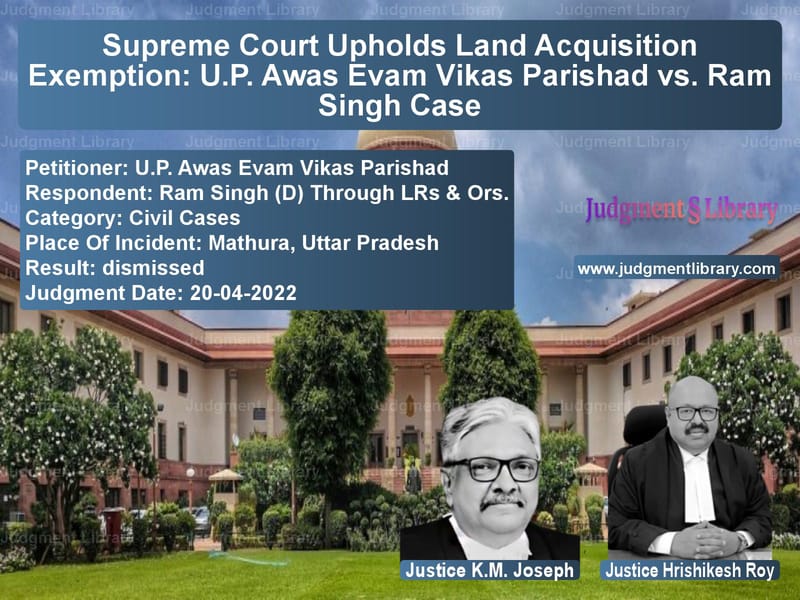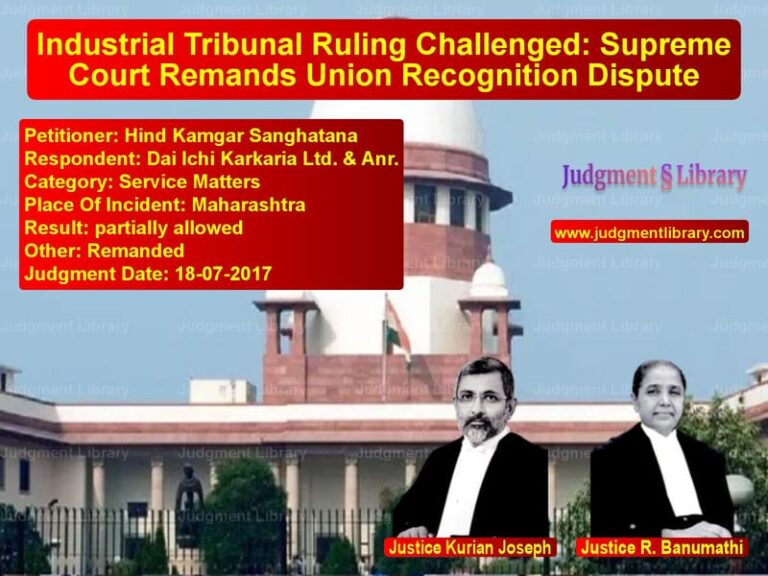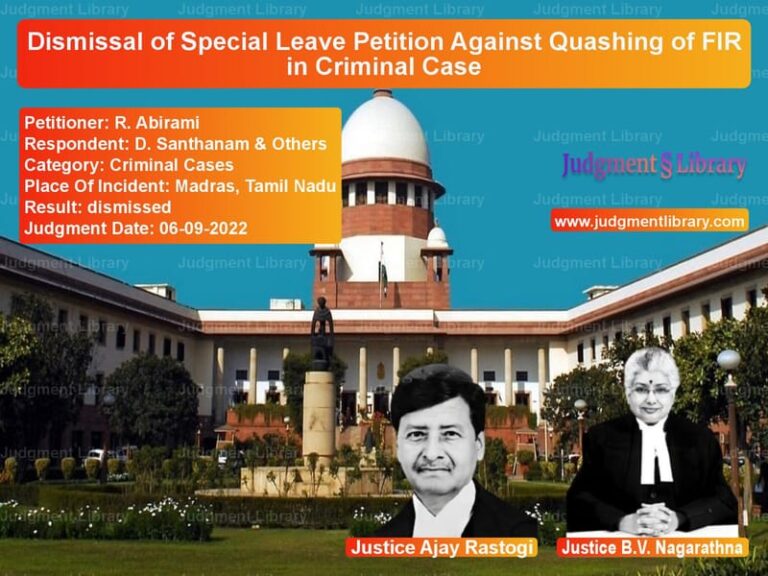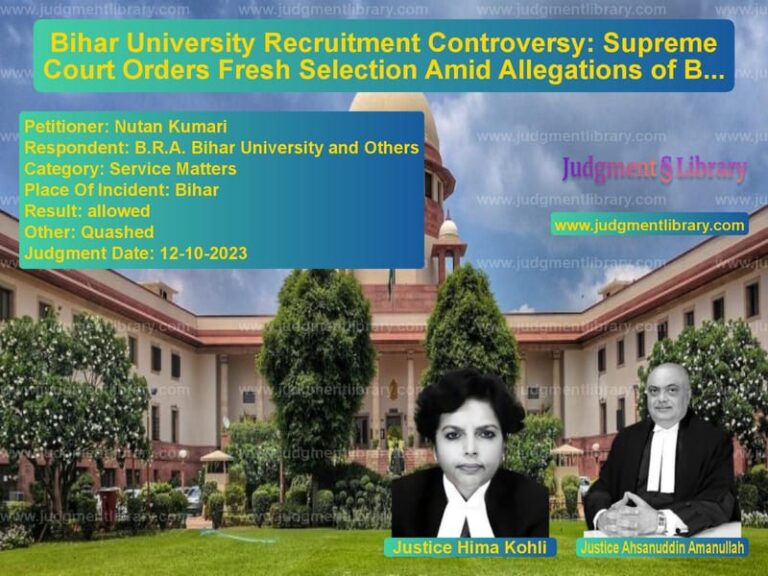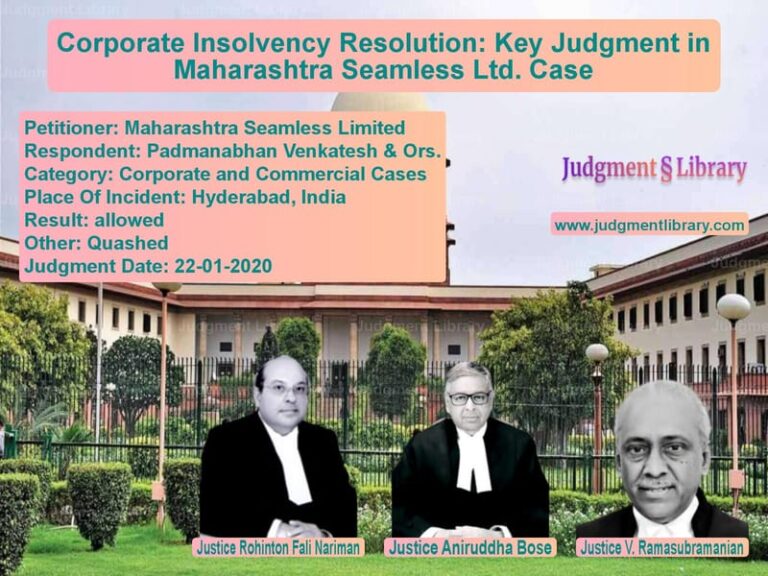Supreme Court Upholds Land Acquisition Exemption: U.P. Awas Evam Vikas Parishad vs. Ram Singh Case
The case of U.P. Awas Evam Vikas Parishad vs. Ram Singh & Ors. revolved around the land acquisition process under the U.P. Awas Evam Vikas Parishad Adhiniyam, 1965. The dispute arose when the Government of Uttar Pradesh issued a notification exempting certain land from acquisition, which the appellant, U.P. Awas Evam Vikas Parishad, challenged on various grounds.
The Supreme Court ultimately upheld the High Court’s decision, rejecting the appellant’s plea to reverse the exemption. The ruling underscores the importance of procedural fairness in land acquisition cases and reaffirms the limited scope of withdrawal once a notification under Section 48 of the Land Acquisition Act is issued.
Background of the Case
The case has a long history, beginning with a notification under Section 28 of the U.P. Awas Evam Vikas Parishad Adhiniyam, 1965, which is equivalent to a notification under Section 4 of the Land Acquisition Act, 1894. This notification, issued on November 10, 1973, proposed the acquisition of land, including Khasra Plot No. 7 and Khasra Plot No. 3, measuring 5.98 acres in Mathura.
Read also: https://judgmentlibrary.com/supreme-court-rejects-review-petition-in-specific-performance-suit/
Subsequent notifications followed:
- August 17, 1977: Notification under Section 32 of the Adhiniyam (equivalent to Section 6 of the Land Acquisition Act).
- July 18, 1979: The urgency clause under Section 17(1) of the Land Acquisition Act was invoked.
- December 11, 1981 & March 31, 1983: The appellant claimed possession of the land.
- September 28, 1985: Award was passed, and compensation was determined.
However, on July 7, 2005, the Government of Uttar Pradesh issued a notification under Section 48(1) of the Land Acquisition Act, withdrawing the land from acquisition. The appellant opposed this, leading to prolonged litigation.
Petitioner’s Arguments
Senior counsel Shri Vishwajit Singh, appearing for U.P. Awas Evam Vikas Parishad, argued that the withdrawal of land acquisition was flawed and against public interest. His key arguments included:
“This is a case where the land forms the subject matter of an approved housing scheme for the Low-Income Group. Withdrawing acquisition disrupts the planning and development process.”
He further contended that:
- The land was legally acquired, and an award was passed.
- Possession was taken, barring any withdrawal under Section 48.
- Withdrawal was granted without consulting the appellant.
- The land was integral to a public housing scheme.
Respondents’ Arguments
On the other hand, senior counsel Shri Yatinder Singh, representing the legal heirs of Ram Singh, defended the withdrawal, arguing:
“Possession within the meaning of Section 48 must be actual and not symbolic. Since possession was never truly taken, withdrawal was legally justified.”
He highlighted the following:
- No proper notice was issued under Section 9 of the Land Acquisition Act.
- Compensation was not paid for nearly two decades.
- The Government had the authority to withdraw the acquisition.
Supreme Court’s Observations
The Supreme Court bench, comprising K.M. Joseph and Hrishikesh Roy, examined the legality of the withdrawal order dated April 25, 2008, which revoked the exemption granted in 2005. The Court ruled in favor of the respondents, emphasizing the following:
“Possession within the meaning of Section 48 of the Land Acquisition Act cannot be symbolic. The restriction on withdrawal applies only when actual possession has been taken.”
Addressing the issue of whether the government could reverse its exemption decision, the Court held:
“Once a notification under Section 48 is issued, it cannot be undone arbitrarily. The decision to withdraw from acquisition must be reasonable and fair.”
Final Ruling
The Supreme Court dismissed the appeals, holding that:
- The notification dated July 7, 2005, exempting the land from acquisition, was valid.
- The notification dated April 25, 2008, canceling the exemption, was invalid.
- The appellant failed to prove that actual possession was taken.
Conclusion
This judgment reaffirms the principles governing land acquisition and withdrawal under Section 48 of the Land Acquisition Act. The ruling emphasizes that governments cannot arbitrarily reverse exemptions once granted, ensuring fairness in the acquisition process. The case serves as a significant precedent in property and land acquisition law, particularly concerning the rights of landowners against acquisition authorities.
Petitioner Name: U.P. Awas Evam Vikas Parishad.Respondent Name: Ram Singh (D) Through LRs & Ors..Judgment By: Justice K.M. Joseph, Justice Hrishikesh Roy.Place Of Incident: Mathura, Uttar Pradesh.Judgment Date: 20-04-2022.
Don’t miss out on the full details! Download the complete judgment in PDF format below and gain valuable insights instantly!
Download Judgment: u.p.-awas-evam-vikas-vs-ram-singh-(d)-throug-supreme-court-of-india-judgment-dated-20-04-2022.pdf
Directly Download Judgment: Directly download this Judgment
See all petitions in Property Disputes
See all petitions in Landlord-Tenant Disputes
See all petitions in Specific Performance
See all petitions in Judgment by K.M. Joseph
See all petitions in Judgment by Hrishikesh Roy
See all petitions in dismissed
See all petitions in supreme court of India judgments April 2022
See all petitions in 2022 judgments
See all posts in Civil Cases Category
See all allowed petitions in Civil Cases Category
See all Dismissed petitions in Civil Cases Category
See all partially allowed petitions in Civil Cases Category

